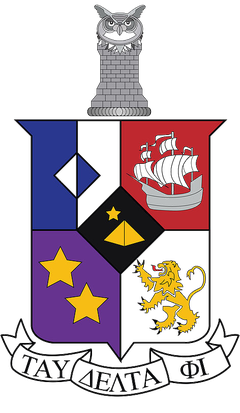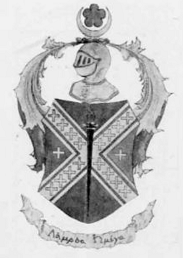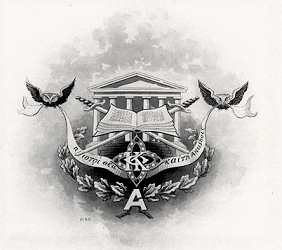
Phi Sigma Kappa (ΦΣΚ), colloquially known as Phi Sig or PSK, is a men's social and academic fraternity with approximately 74 active chapters and provisional chapters in North America. Most of its first two dozen chapters were granted to schools in New England and Pennsylvania; therefore its early development was strongly Eastern in character, eventually operating chapters at six of the eight Ivy League schools as well as more egalitarian state schools. It later expanded to the South and West.

Phi Sigma Phi,(ΦΣΦ) is a national fraternity in the United States founded on July 30, 1988 in South Bend, Indiana by chapters formerly of Phi Sigma Epsilon that declined to participate in that fraternity's merger into Phi Sigma Kappa. There are currently 5 active chapters of Phi Sigma Phi nationwide. The current National President is University of Wisconsin-Stevens Point Alumn Joshua Finch.

Tau Delta Phi (ΤΔΦ), whose members are commonly known as Tau Delts, is a national social fraternity founded on June 22, 1910, in New York City. Since its inception, dozens of chapters have been founded and thousands of men initiated into its membership. Today, Tau Delta Phi fraternity operates five active chapters and colonies located primarily in the northeastern United States.

Lambda Omega (ΛΩ) was a national collegiate sorority operating in the United States from October 31, 1915 until 1933.
Beta Phi Alpha (ΒΦΑ) was a national collegiate sorority operating under that name in the United States from 1919 until 1941. It was absorbed by Delta Zeta sorority.

Alpha Lambda Tau (ΑΛΤ) was a men's college fraternity founded in 1916 at Oglethorpe University. For its first decade Alpha Lambda Tau permitted expansion only within the southern states. At the start of its fourth decade, in 1946, the national organization of Alpha Lambda Tau dissolved; the majority of its chapters affiliated with Tau Kappa Epsilon.

Kappa Sigma Kappa (ΚΣΚ) is the name of three separate college fraternities, sharing a common history and traditions but disconnected by decades and a break in organizational continuity.

Delta Kappa Phi (ΔΚΦ) is a professional–social collegiate fraternity established in 1899, and located in the United States. As of 2017 it has one active chapter.

Phi Kappa (ΦΚ) was a social fraternity founded on October 1, 1889 by a group of Catholic students at Brown University who were refused entrance to other fraternities because of their faith. On April 29, 1959, Phi Kappa merged with a similar fraternity Theta Kappa Phi to form Phi Kappa Theta.
Chi Tau (ΧΤ) was a small national men's fraternity founded on October 3, 1920 at Trinity College, the predecessor to Duke University. The majority of its 9 chapters were in North Carolina. It disbanded at the start of the Great Depression, with members and chapters dispersing by 1929. At least two chapters lingered as independent organizations for several years.
Sigma Delta Rho (ΣΔΡ) was a small national men's fraternity founded on January 8, 1921 at Miami University of Ohio, the fifth general social fraternity to be formed at that school. It "disintegrated" in the spring of 1935 due to pressures of the Great Depression and "absence of strong leadership." About half its chapters were absorbed into other fraternities.

Sigma Phi Sigma (ΣΦΣ) was a national collegiate fraternity founded in 1908 at the University of Pennsylvania. It ceased operations during WWII and was unable to restart as a national entity, with several chapters joining other fraternities, predominantly Phi Sigma Kappa.

Phi Psi (ΦΨ) is a professional fraternity in the field of textile arts and manufacturing engineering.










